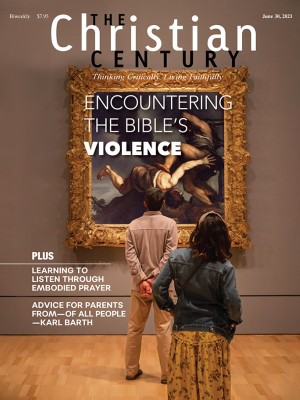Seven things I learned by teaching a Me Too Bible class
Scripture is filled with sexual violence. So, we learned, are our own lives.

The Me Too movement has empowered many survivors to speak up about the sexual abuse and assault they have experienced. What was once secret, and consequently enabled and viewed as acceptable, has been coming to light and is being deemed unacceptable.
Many of us have followed the movement in the news or on social media, and we’ve heard personal stories from people we know. We learned of the sexual misconduct and spiritual abuse by Christians as well-known as Ravi Zacharias and Jean Vanier. We followed the case of Harvey Weinstein, the Hollywood tycoon convicted of rape. We watched the movie Bombshell, about the women at Fox News who stood up to Roger Ailes and his sexual harassment, and shook our heads. The more diligent among us may have even taken a closer look at our church policies on sexual misconduct.
Read our latest issue or browse back issues.
But what will it take to ensure that the Me Too wave continues, rather than peaking and subsiding? One thing we need is for sexual assault and harassment to be discussed in the local church—with Bibles out and with listening ears, questioning minds, and open hearts.
At a mandatory workshop for pastors at my local presbytery, I learned about sexual harassment—its definition, how to recognize it, its destructive consequences, and how pastors should deal with it in our various ministries. This is good and faithful work. Yet having experienced sexual harassment as a pastor and having carried the pain from it, I attended the workshop with a certain unease. I felt like it only began to address the festering sin of sexual harassment, as if to offer a small Band-Aid on a gaping, stinging wound.
I decided to create an adult education course on the Bible and the Me Too movement. Every Sunday morning, during the Sunday school hour at Peace Presbyterian Church (Lakewood Ranch, Florida), we studied tough scripture passages on sexuality, power, and violence. Here are some reflections on that difficult, worthwhile experience.
1. Create a safe space for learning together.
A strong rapport among the group provides a necessary cushion for exploring tough and painful biblical territory. During the first session, we talked about people’s motivation for attending. Baby boomer grandmas wanted to understand their daughters’ and granddaughters’ world better. Bible nerds simply wanted to study the Bible, especially the tough texts that may not show up in the lectionary. And as time passed and trust blossomed, it emerged that survivors among us needed to share their personal stories and name their hurt.
2. Be okay with discomfort.
It will constantly hover in the room, and creating a safe space means accepting this. The class did not provide biblical prescriptions for pain. Each attendee had to sit with each ancient Me Too scripture passage—not defend it or excuse it but simply read it, name it as wrong, and be uncomfortable with how it has been misused or hidden from everyday Christian life. Any hope of healing involves trusting the process of pain. There is no need to rush in and clean up a mess that is still being uncovered.
3. Affirm anger as a faithful response to scripture.
During our first study, on Sodom and Gomorrah (Gen. 19:1–23), a lesbian woman in our class sat silently until finally she spoke: “I’m sorry, but I am sitting over here so angry about this story. This story is taught to condemn homosexuality?! This story is about rape!”
There began our class’s identification of the need to affirm anger. When we looked at David and Bathsheba (2 Sam. 11:1–12:25), someone asked, “Did Bathsheba even know that her son died because of David’s sin?” Others shook their heads and said, “This was taught to me as a love story.”
On the rape of the concubine (Judg. 19:1–20:11): “Why chop this woman’s body into pieces? Would she even be recognizable?” Another person said, “These people knew the Ten Commandments by this point. They should know better!” On the rape of Tamar (2 Sam. 13:1–22): “Why was Tamar condemned to her house and silenced by her brother Absalom after Amnon raped her?” The room filled with disgust as someone responded, “At least she had a name and a voice. Others didn’t even have that.” On the rape of Dinah and its aftermath (Gen. 34:1–31): “Why do men enable each other’s wrong behavior?” Questions like these—and anger—are necessary and faithful companions.
4. Look for the good.
As we affirmed our anger and asked questions, we learned how easy it is to get stuck and suffocate in such tricky territory. We also needed some positive stories from scripture, to breathe life and good news into each class.
We talked about Jael, who shows incredible strength when she overtakes the enemy Sisera in her tent (Judg. 4:17–22). Someone brought up Naomi, Ruth’s widowed mother-in-law, whose shrewdness secures power and security for their future (Ruth 3:1–5). And the other Tamar, who along with Ruth is part of Jesus’ family line (Matt. 1:3–5), takes control of a situation in which she is disadvantaged by exposing Judah’s injustice (Gen. 38:1–26).
We also looked at examples from the Gospels. The hemorrhaging woman asserts her needs and is healed (Mark 5:21–43). The Samaritan woman’s bold inquisitiveness and testimony leads her whole town to Jesus (John 4:1–30). The woman who anoints Jesus recognizes his suffering and is commended by him (Mark 14:3–9).
Looking for the good in scripture, while also acknowledging the pain of the Me Too passages, helped balance the class and focus it on good news.
5. Allow room for personal stories. Respond pastorally and faithfully.
Part of the strength of the Me Too movement has been its packaging in the power of story. As biblical stories are discussed honestly and as group rapport grows, inevitably, personal stories will emerge. Listen well, remind the group of confidentiality, and encourage survivors. I often found myself saying, “I am sorry this has happened to you. Thank you for entrusting your story to us. You have a lot of courage.” Have counseling referrals ready and make them available during the first session.
The stories are upsetting, but sharing them can empower survivors. One observer commented, “How many people have ever admitted this pain? This class listens to the victim and affirms their story as wrong—and it does so in church!” Our class heard of a male associate pastor who was invited to skinny dip by a senior pastor, said no, and lost his job. A woman recalled when a best friend’s older brother repeatedly exposed himself and wrestled her to the ground. Another woman talked about being molested as a 12-year-old by her best friend’s father as his wife watched.
Other attendees, reflecting on their careers, confessed to letting “locker room talk” slide in order to maintain their jobs; they talked about pastors they knew who were able to maintain their jobs because moving forward with a church building project was considered more important than addressing the pastor’s sexual harassment and intimidation of minors and coworkers. The stories and survivors are there, waiting to be listened to.
6. Notice who is not there. Don’t be too quick to judge.
Many church members never set foot in the class but asked about it regularly. I repeatedly responded to conversations initiated by men who were a bit nervous to set foot in the female-dominated room. Upon learning this, some people shook their heads in anger and disgust: “Why wouldn’t the men of the church come to this?” The suggestion was that the men were obliged to sit and take the heat of collective wrongdoing.
I felt similarly at first. But as time passed, I learned to trust the Holy Spirit to guide the attendance. Just because this topic doesn’t attract every person in church doesn’t mean that God isn’t at work. The people who were there were present because God led them to the table. And to be quick to judge those not in attendance is to discourage them from engaging with the topic. Encourage people to engage, wherever they are, and lead with both courage and humility.
7. Keep talking.
The last session was devoted to decompression and reflection. I encouraged people to be thoughtful and creative in what and how they chose to share. Some wrote song lyrics, some performed songs of lament from the victim’s perspective, and others discussed the importance of reading the Bible together—especially the tough texts. Plans were initiated for a support group for survivors of sexual assault. We talked about how the work of the class was nowhere near complete. The Me Too movement doesn’t end with sharing personal stories or naming an act as wrong; it requires consistently confronting a system, a system that will inevitably retaliate.
Others mentioned warning signs within church walls once sexual assault and abuse are addressed. Watch for secrets. Watch for the spiritual abuse of being called un-Christian, judgmental, or unforgiving in such situations. Pushback is inevitable, making courses like this one an important step toward support and solidarity for a long road ahead.
The course at my church enriched the faith of every person who attended. There has been talk of offering it again with a deliberate intention to include men. The class challenged us to understand scripture, God, and ourselves better, and it motivated us to stand together. It highlighted Jesus’ call to enter through the narrow gate, which leads to a hard road but also to life (Matt. 7:13–14). I’m convinced that it’s time to turn on the light, peel off the worn-out Band-Aid, witness the wounds, feel the sting that comes from confrontation, apply the balm of shared experience, and begin the long path with Jesus toward healing.
A version of this article appears in the print edition under the title “A hard class on hard stories.”






